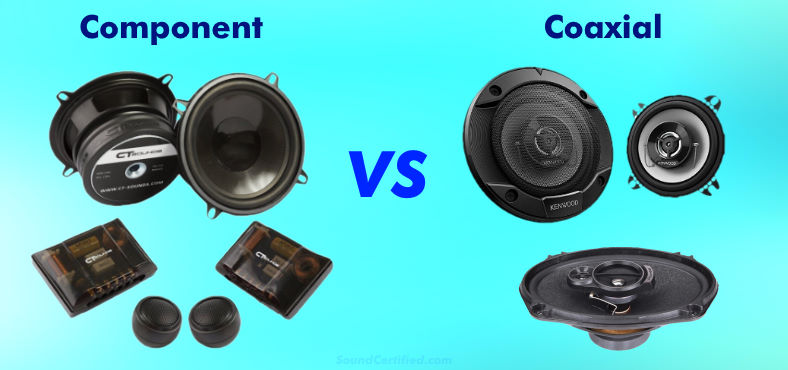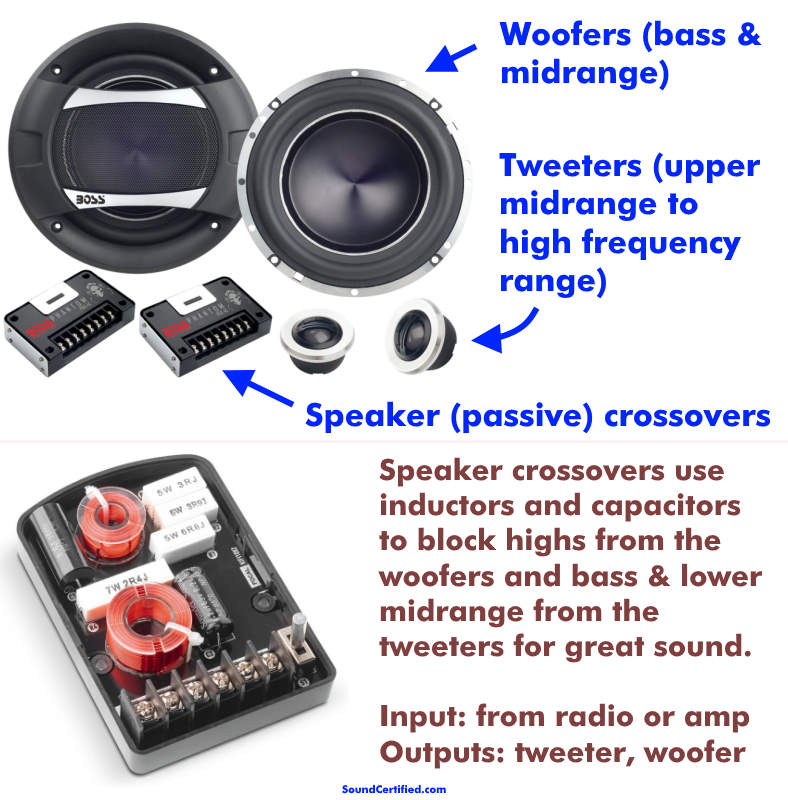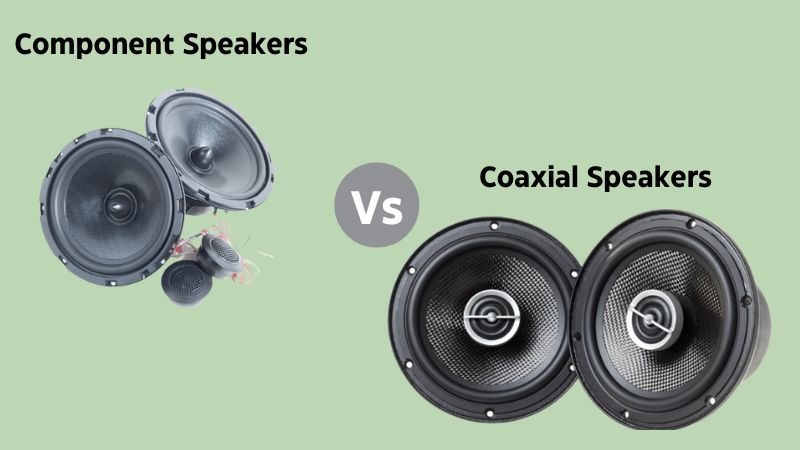Component speakers are a type of speaker system that separates sound into different components for more precise audio performance. These systems typically include separate tweeters, woofers, and external crossovers.
When upgrading your car audio system, choosing the right components can make a significant difference in sound quality. Component speakers allow for better sound staging, imaging, and higher clarity, enhancing your overall listening experience. With the ability to adjust and fine-tune each component individually, you can customize the sound to your preferences.
We will explore the benefits of component speakers, how they work, and why they are a popular choice for audiophiles looking to elevate their car audio setup. Let’s dive in and discover the world of component speakers.
Advantages Of Component Speakers
Improved Sound Quality
Component speakers are designed to offer superior sound quality compared to coaxial speakers. The separate components, including the tweeters, woofers, and crossovers, allow for a more precise and detailed audio output. This heightened sound clarity provides a more immersive listening experience, ideal for audiophiles and car enthusiasts seeking pristine sound reproduction.
Better Separation Of Frequencies
With distinct components dedicated to handling specific frequency ranges, component speakers provide better separation of frequencies. This prevents audio distortion, resulting in a cleaner and more accurate sound reproduction. The dedicated tweeters for high frequencies and woofers for mid-range and bass ensure that each audio element is reproduced with precision, enhancing the overall listening experience.
Customization Options
Component speakers offer customization options, allowing you to tailor the audio setup to your preferences. From adjusting the speaker placement to selecting specific components to match your desired sound profile, the flexibility of component speakers enables you to create a personalized audio system that suits your unique preferences and acoustic requirements.

Credit: www.amazon.com
Types Of Component Speakers
Component speakers are a type of car audio system that separates the different sound frequencies into individual components, such as tweeters for high frequencies and woofers for low frequencies. This provides a clearer and more balanced sound compared to coaxial speakers.
They are favored by audiophiles for their superior sound quality and customization options.
three main types of component speakers used in car audio systems.Midrange Speakers
notes in the middle of the sound spectrum, enhancing vocals and instrumental tones.Tweeters
high-frequency sounds such as cymbals, strings, and vocal harmonies with clarity.Woofers
low-frequency sounds, delivering deep bass tones and enhancing the overall audio experience.Factors To Consider Before Buying Component Speakers
Factors to Consider before Buying Component Speakers:
Power Handling
Speaker power handling determines the amount of power a speaker can handle without damage, measured in watts.
Sensitivity
Sensitivity refers to how loud a speaker can get with a given amount of power, measured in decibels.
Frequency Response
Frequency response indicates the range of frequencies a speaker can reproduce accurately.
Mounting Depth
Mounting depth is crucial as it determines how much space is required for installation.
Installation Process
When it comes to upgrading your car audio system, the installation process of component speakers is one of the crucial steps that directly impacts the sound quality. Proper installation ensures optimal performance and a seamless integration with your vehicle’s audio system. In this guide, we’ll walk through the step-by-step process of installing component speakers, from gathering the necessary tools to securing and testing the new speakers.
Gathering The Necessary Tools
Before getting started, prepare the following tools for the installation process:
- Phillips head screwdriver
- Panel removal tool
- Wire cutters/strippers
- Socket/ratchet set
- Electrical tape
- Speaker wire
Removing The Factory Speakers
To begin, carefully remove the panels covering the factory speakers using a panel removal tool. Use a Phillips head screwdriver to unscrew the existing speakers from their mounts. Once removed, disconnect the wiring harness from the speaker and set aside the factory speakers.
Wiring The Component Speakers
Connect the speaker wire from the crossover to the component speakers, ensuring the positive and negative terminals are properly aligned. Then, connect the crossover to the car stereo’s wiring harness, following the manufacturer’s instructions for proper wiring.
Securing And Testing The New Component Speakers
Mount the component speakers into the designated openings, securing them with screws and ensuring a snug fit. Once installed, test the speakers to verify that they are functioning properly and that the sound quality meets your expectations.
Tips For Getting The Best Sound Quality
When it comes to upgrading your car’s audio system, component speakers are a popular choice. These speakers offer superior sound quality and allow you to customize your setup to suit your preferences. To ensure you get the most out of your component speakers, here are some important tips to keep in mind.
Proper Speaker Placement
Maintaining proper speaker placement plays a crucial role in achieving optimal sound quality. Positioning your component speakers in the right locations can make a significant difference in your listening experience. Here are a few guidelines to follow:
- Place the tweeters at ear level: Mounting the tweeters at a level that aligns with your ears helps improve sound stage and imaging.
- Install the woofer in appropriate locations: Experiment with different locations within your car to find the spot that provides the best bass response.
- Consider placing the midrange drivers near the center: This positioning helps improve the overall audio balance.
Sound Deadening
To achieve the best sound quality from your component speakers, focussing on sound deadening is crucial. Sound deadening materials reduce noise, vibrations, and resonances, providing a more pleasant and immersive audio experience. Some popular sound deadening techniques include:
- Applying damping materials to panel surfaces: Use products like butyl rubber sheets or vibration-damping mats on the doors, floor, and trunk to minimize rattling and vibrations.
- Adding foam or closed-cell foam insulation: These materials help reduce airborne noise, improving the clarity of your speakers.
- Sealing any gaps or leaks: Check for any openings in the car’s bodywork, such as around the wiring harnesses, and seal them to prevent sound leakage.
Amplifying The Signal
To ensure your component speakers reach their full potential, amplifying the signal is crucial. Amplifiers provide the necessary power required to produce higher volume levels and better sound quality. Here are a few recommendations:
| Amplifier Wattage | Recommended Speaker Power |
|---|---|
| 25-50 watts RMS | 50-75 watts RMS |
| 50-75 watts RMS | 75-100 watts RMS |
| 75-100 watts RMS | 100-150 watts RMS |
Matching the amplifier’s power output to your component speakers’ power handling ensures that they operate efficiently and deliver the best sound quality possible.
Remember, following these tips will significantly enhance your component speakers’ performance and provide you with an immersive and enjoyable audio experience every time you hit the road.

Credit: soundcertified.com
Common Mistakes To Avoid
When it comes to upgrading your car audio system, component speakers are a popular choice. These speakers offer superior sound quality and allow for customization to meet your audio preferences. However, there are a few common mistakes that many people make when installing component speakers. By being aware of these mistakes, you can ensure that you get the most out of your component speaker upgrade.
Incorrect Wiring
One of the biggest mistakes car owners make when installing component speakers is incorrect wiring. This can lead to poor sound quality, and in some cases, even damage to the speakers. It is crucial to follow the manufacturer’s instructions carefully and make sure that the wires are correctly connected. Additionally, using the wrong gauge of wire can result in overheating or blown fuses. To avoid these issues, it is recommended to consult a professional or refer to a reliable wiring guide for proper installation.
Mismatched Components
Another common mistake is using mismatched components. Component speakers consist of separate tweeters, woofers, and crossovers that work together to produce high-quality sound. It is important to choose components that are compatible with each other to ensure proper functioning and optimal sound performance. Mismatched components can lead to imbalanced sound, distortion, and even damage to the speakers. Before purchasing component speakers, it is crucial to do proper research and ensure that all the components are compatible with your car’s audio system.
Improper Speaker Enclosure
The speaker enclosure plays a crucial role in the sound quality produced by component speakers. A common mistake many people make is neglecting the importance of a proper speaker enclosure. The enclosure affects the bass response, clarity, and overall sound performance. It is essential to choose the right type of enclosure that matches your speaker’s specifications and your desired sound preferences. The two main types of enclosures are sealed and ported. Each has its own advantages and disadvantages, so it is important to choose wisely based on your specific needs and audio goals. Investing in a high-quality enclosure can significantly enhance the sound quality of your component speakers.
By avoiding these common mistakes, you can ensure that your component speakers deliver the extraordinary sound experience that they are designed to provide. Take the time to properly wire your speakers, choose matching components, and invest in a suitable speaker enclosure. Doing so will not only enhance your car audio system but also prolong the lifespan of your component speakers. With the right installation and setup, you can enjoy the superior sound quality and immersive audio experience that component speakers offer.

Credit: soundcertified.com
Frequently Asked Questions Of What Are Component Speakers
What Are Component Speakers And How Do They Differ From Coaxial Speakers?
Component speakers are a type of car audio speakers that are designed to provide superior sound quality. Unlike coaxial speakers, which have all the speaker components (woofer, tweeter, and sometimes midrange) integrated into a single unit, component speakers have separate speakers for each component.
This allows for better sound imaging and clarity.
What Are The Benefits Of Using Component Speakers In A Car Audio System?
Using component speakers in a car audio system offers several benefits. Firstly, component speakers produce clearer and more detailed sound due to the separation of speaker components. Secondly, they offer better sound staging and imaging, with the ability to place speakers in optimal positions.
Lastly, component speakers can handle higher power outputs, resulting in better overall audio performance.
What Factors Should I Consider When Choosing Component Speakers For My Car?
When choosing component speakers for your car, there are several factors to consider. Firstly, ensure compatibility with your car’s audio system and power output. Secondly, consider the size and mounting options to make sure they fit your car’s speaker locations.
Lastly, pay attention to the speaker’s frequency response, sensitivity, and power handling capabilities to match your sound preferences and requirements.
How Do I Install Component Speakers In My Car?
Installing component speakers in your car might require some basic knowledge of car audio systems or professional help. Start by removing the old speakers and making sure the new component speakers fit in the car’s speaker locations. Connect the speaker wires properly, ensuring correct polarity.
Secure the speakers in place and test the sound before finishing the installation.
Conclusion
Component speakers offer distinct advantages in sound quality and customization. Their separate components allow for better positioning and improved clarity. With the ability to tailor each element to your preferences, component speakers deliver an immersive audio experience. Upgrade your car’s sound system with these versatile and high-performance speakers.


0 comments